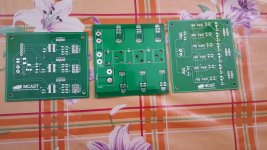glenn0010
100 W
Hey Again Guys!
So work has been ongoing and each time I think my PCB design is done, I change something. Having said that my gate driver board and supply board are done. The only thing that's left to be finalized for now is the Inverted board. This will allow me to test the motor in open loop. The sensing board will come later.
Having said that, if anyone technical is reading this, I need your help!
I am trying to work out what size heat sinks I need for my transistors. Attached you can find the MOSFET's datasheet that I am using, an application note which outlines how to calculate the mosfet's power losses and the calculations I made using the Excel Sheet. (Note: the supply voltage is 48V and the motor current shall be 20A)
In the excel sheet the cells in bright pink I am not 100% sure if I took the correct reading on them so this is why I need your help. Also provided that my calculations are correct, what is my next step in choosing a heatsink? I was thinking to bend the transistors so the case(back) would be facing upward, and I would bolt a 10cm by 10cm by 0.5cm aluminium plate as a heatsink to all the transistors similar to a cpu cooler if this would be able to dissipate the heat made. Else I was think that on top of the plate I would also connect an old GPU cool I have lying around if the plate alone is not enough.
What are your thoughts?
Thanks in Advance
So work has been ongoing and each time I think my PCB design is done, I change something. Having said that my gate driver board and supply board are done. The only thing that's left to be finalized for now is the Inverted board. This will allow me to test the motor in open loop. The sensing board will come later.
Having said that, if anyone technical is reading this, I need your help!
I am trying to work out what size heat sinks I need for my transistors. Attached you can find the MOSFET's datasheet that I am using, an application note which outlines how to calculate the mosfet's power losses and the calculations I made using the Excel Sheet. (Note: the supply voltage is 48V and the motor current shall be 20A)
In the excel sheet the cells in bright pink I am not 100% sure if I took the correct reading on them so this is why I need your help. Also provided that my calculations are correct, what is my next step in choosing a heatsink? I was thinking to bend the transistors so the case(back) would be facing upward, and I would bolt a 10cm by 10cm by 0.5cm aluminium plate as a heatsink to all the transistors similar to a cpu cooler if this would be able to dissipate the heat made. Else I was think that on top of the plate I would also connect an old GPU cool I have lying around if the plate alone is not enough.
What are your thoughts?
Thanks in Advance


